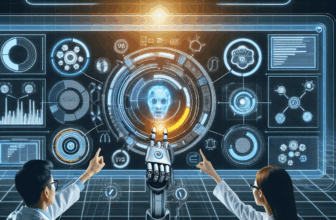Revolutionizing Retail: The Benefits of AI-Powered Smart Product Categorization
Table of Contents
- Introduction
- Understanding Smart Product Categorization
- The Role of Artificial Intelligence in Retail
- Benefits of AI-Powered Smart Product Categorization
- Case Studies: Successful Implementations
- Challenges and Limitations
- Future Trends in AI-Powered Categorization
- Conclusion and Recommendations
- FAQ
- Resources
- Disclaimer
Introduction
The retail industry is in the midst of a transformative era, as technological advancements disrupt traditional business models. Among these advancements, AI-powered smart product categorization has emerged as a groundbreaking approach for organizations striving to improve operational efficiency, enhance customer satisfaction, and drive sales. This article explores how AI-driven categorization optimizes retail businesses by dissecting its advantages, case studies, challenges, and future prospects.
Understanding Smart Product Categorization
What is Smart Product Categorization?
Smart product categorization refers to the automated organization of products into relevant categories and subcategories using advanced algorithms and machine learning techniques. This process relies on analyzing product attributes, sales data, customer behavior, and market trends to determine the most suitable categorization structure.
The Importance of Categorization in Retail
Effective categorization plays a crucial role in retailing. It affects inventory management, customer experience, and even search engine optimization. By presenting products in a coherent and intuitive manner, retailers can improve product discoverability, leading to increased sales.
The Role of Artificial Intelligence in Retail
How AI is Transforming Retail
Artificial Intelligence has revolutionized numerous aspects of retail, including supply chain management, customer service, and marketing. AI algorithms analyze vast amounts of data to uncover insights that drive intelligent decision-making.
AI Technologies in Product Categorization
Several AI technologies power smart product categorization:
- Natural Language Processing (NLP): NLP analyzes product descriptions to identify relevant categories based on linguistic patterns.
- Machine Learning (ML): ML algorithms learn from historical sales data to optimize categorization structures dynamically.
- Computer Vision: This technology examines images and videos to extract visual attributes of products, aiding in their categorization.
Benefits of AI-Powered Smart Product Categorization
Improved Customer Experience
AI-powered categorization enhances the customer journey by providing users with tailored product recommendations and making navigation seamless. Customers can find products quickly, reducing frustration and increasing satisfaction levels.
Operational Efficiency
The automation of categorization workflows results in significant time savings for retail staff, allowing them to focus on more strategic tasks. By minimizing manual efforts, retailers can streamline operations and reduce human error.
Enhanced Sales and Conversion Rates
Through intelligent product categorization, retailers can optimize their online merchandising strategies. By ensuring that products are accurately placed in relevant categories, retailers can improve visibility, which can lead to increased sales and conversion rates.
Data-Driven Insights
AI categorization provides retailers with valuable analytics regarding product performance, customer preferences, and emerging trends. This data empowers businesses to make informed decisions about inventory management, marketing campaigns, and product offerings.
Case Studies: Successful Implementations
Case Study 1: Amazon
Amazon, the global e-commerce phenomenon, utilizes AI-driven product categorization to manage its extensive inventory. By categorizing millions of products efficiently, Amazon ensures that customers can discover what they need quickly. The company leverages machine learning algorithms that continuously improve the categorization process based on user interactions.
Case Study 2: Walmart
Walmart has integrated AI into its product categorization processes to enhance its e-commerce platform. By using AI technologies to analyze customer data and merchandise trends, Walmart has optimized its online store layout, leading to improved user navigation and increased sales.
Challenges and Limitations
Data Quality and Volume
One of the primary challenges facing retailers implementing AI-powered categorization is the quality and volume of data available. Inconsistent or insufficient data can lead to inaccurate categorizations and poor customer experiences.
Integration with Existing Systems
Integrating AI solutions with legacy systems can be complex and costly. Retailers may encounter difficulties when trying to harmonize disjointed databases, resulting in operational inefficiencies.
Resource Constraints
Many retailers, especially small to mid-sized businesses, may lack the necessary resources, including budgets and skilled personnel, to effectively implement AI-powered categorization systems. Budgetary constraints can limit the extent of adoption and optimization.
Future Trends in AI-Powered Categorization
Advanced Personalization
As AI technology develops, the ability to offer hyper-personalized shopping experiences will escalate. Retailers will leverage customer behavior data more effectively to create bespoke product categorizations that cater specifically to individual preferences.
Increased Automation
The future will see retailers adopting even more sophisticated AI models that automate not only categorization but also other aspects of inventory management and marketing, thereby achieving higher operational efficiency.
Augmented Reality (AR) Integration
The incorporation of AR in product categorization could revolutionize how customers interact with products online. Through AR, consumers may visualize how products fit into their lives, leading to better purchasing decisions.
Conclusion and Recommendations
AI-powered smart product categorization represents a significant opportunity for retailers to enhance customer experience, improve operational efficiency, and drive sales. In a dynamic and competitive market, businesses must adopt these innovative solutions to stay ahead. Adopting a phased approach to implementation, focusing on data quality, and fostering a culture of continuous learning will be key to successful AI integration in retail.
FAQ
What is AI-powered smart product categorization?
AI-powered smart product categorization is the automated organization of products into relevant categories using machine learning algorithms and data analytics.
How does AI enhance customer experience in retail?
AI enhances customer experience by personalizing product recommendations, optimizing search functionalities, and providing seamless navigation through product categories.
What are some challenges of implementing AI categorization systems?
Challenges include data quality issues, integration difficulties with existing systems, and resource constraints in terms of budget and skilled personnel.
Resources
| Source | Description | Link |
|---|---|---|
| McKinsey & Company | A report on how AI is transforming retail. | McKinsey Retail AI Report |
| Gartner | Insight on AI trends in retail. | Gartner AI Insights |
| Forrester Research | Exploring the evolving landscape of retail AI. | Forrester Retail AI Research |
Disclaimer
This article is produced by A.I. and is currently in Beta Testing. While great care has been taken to ensure accuracy, please verify all information and consult with specific experts before making decisions based on contents within this article.










